Sociology Assignment: Planning Creative Activities for Early Childhood
VerifiedAdded on 2022/10/10
|17
|3565
|324
Homework Assignment
AI Summary
This sociology assignment outlines various activities designed to foster creativity in children, aligning with the CHCECE018 unit. The assignment includes detailed plans for activities like growing a sapling, painting, and collaborative projects based on nursery rhymes. It emphasizes teaching techniques, using open-ended materials, and creating opportunities for children to collaborate creatively. The framework of Belonging, Being, and Becoming is used to structure activities. The assignment also covers methods for evaluating children's learning through assessments of cognitive, speech, and motor skills, along with reflective modifications to the curriculum. Furthermore, it provides portfolios demonstrating the planning of creative environments, the use of open-ended materials, and the integration of learning frameworks. The assignment also explores the use of open-ended materials and how they support children's creative expression.
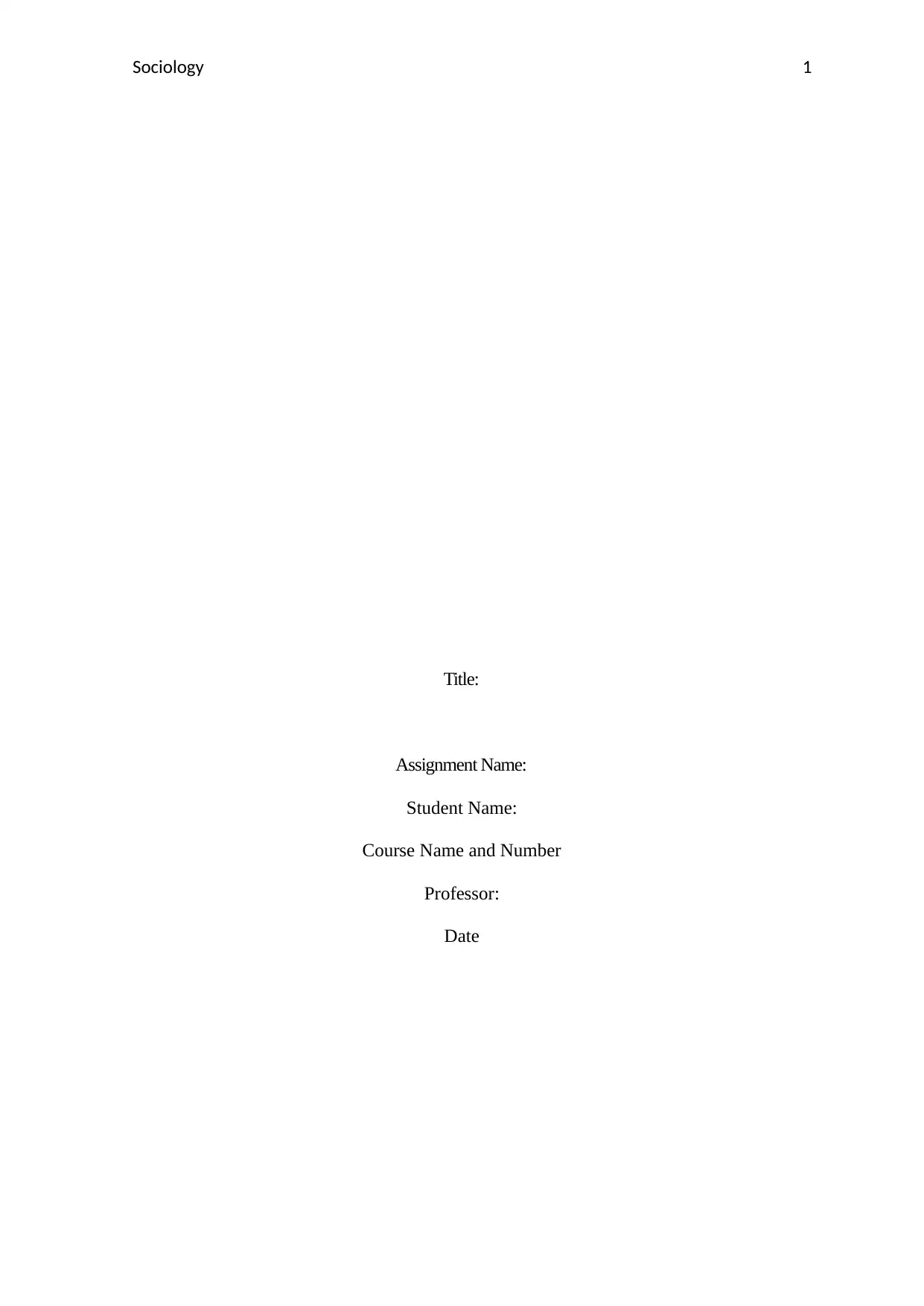
Sociology 1
Title:
Assignment Name:
Student Name:
Course Name and Number
Professor:
Date
Title:
Assignment Name:
Student Name:
Course Name and Number
Professor:
Date
Paraphrase This Document
Need a fresh take? Get an instant paraphrase of this document with our AI Paraphraser
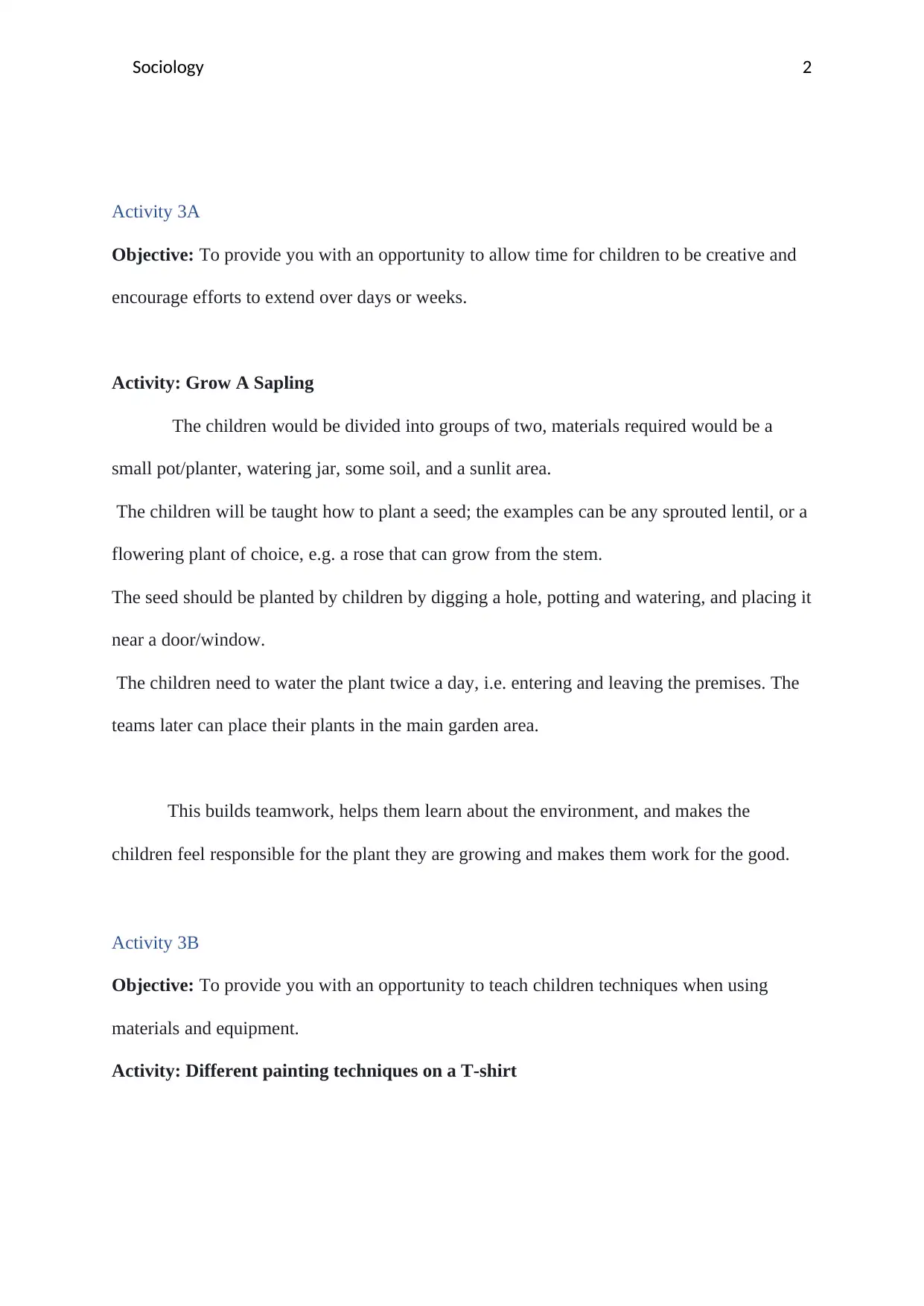
Sociology 2
Activity 3A
Objective: To provide you with an opportunity to allow time for children to be creative and
encourage efforts to extend over days or weeks.
Activity: Grow A Sapling
The children would be divided into groups of two, materials required would be a
small pot/planter, watering jar, some soil, and a sunlit area.
The children will be taught how to plant a seed; the examples can be any sprouted lentil, or a
flowering plant of choice, e.g. a rose that can grow from the stem.
The seed should be planted by children by digging a hole, potting and watering, and placing it
near a door/window.
The children need to water the plant twice a day, i.e. entering and leaving the premises. The
teams later can place their plants in the main garden area.
This builds teamwork, helps them learn about the environment, and makes the
children feel responsible for the plant they are growing and makes them work for the good.
Activity 3B
Objective: To provide you with an opportunity to teach children techniques when using
materials and equipment.
Activity: Different painting techniques on a T-shirt
Activity 3A
Objective: To provide you with an opportunity to allow time for children to be creative and
encourage efforts to extend over days or weeks.
Activity: Grow A Sapling
The children would be divided into groups of two, materials required would be a
small pot/planter, watering jar, some soil, and a sunlit area.
The children will be taught how to plant a seed; the examples can be any sprouted lentil, or a
flowering plant of choice, e.g. a rose that can grow from the stem.
The seed should be planted by children by digging a hole, potting and watering, and placing it
near a door/window.
The children need to water the plant twice a day, i.e. entering and leaving the premises. The
teams later can place their plants in the main garden area.
This builds teamwork, helps them learn about the environment, and makes the
children feel responsible for the plant they are growing and makes them work for the good.
Activity 3B
Objective: To provide you with an opportunity to teach children techniques when using
materials and equipment.
Activity: Different painting techniques on a T-shirt
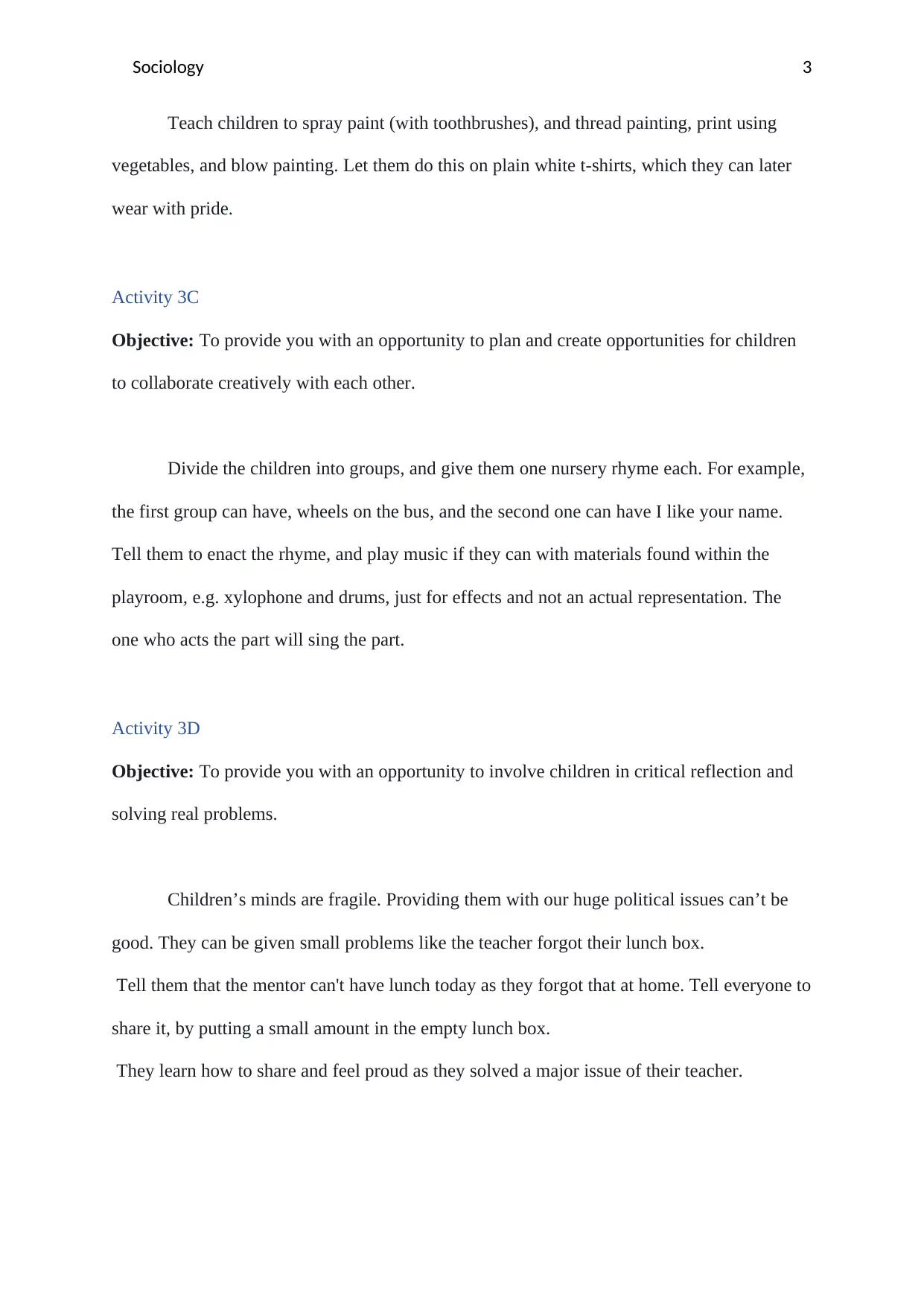
Sociology 3
Teach children to spray paint (with toothbrushes), and thread painting, print using
vegetables, and blow painting. Let them do this on plain white t-shirts, which they can later
wear with pride.
Activity 3C
Objective: To provide you with an opportunity to plan and create opportunities for children
to collaborate creatively with each other.
Divide the children into groups, and give them one nursery rhyme each. For example,
the first group can have, wheels on the bus, and the second one can have I like your name.
Tell them to enact the rhyme, and play music if they can with materials found within the
playroom, e.g. xylophone and drums, just for effects and not an actual representation. The
one who acts the part will sing the part.
Activity 3D
Objective: To provide you with an opportunity to involve children in critical reflection and
solving real problems.
Children’s minds are fragile. Providing them with our huge political issues can’t be
good. They can be given small problems like the teacher forgot their lunch box.
Tell them that the mentor can't have lunch today as they forgot that at home. Tell everyone to
share it, by putting a small amount in the empty lunch box.
They learn how to share and feel proud as they solved a major issue of their teacher.
Teach children to spray paint (with toothbrushes), and thread painting, print using
vegetables, and blow painting. Let them do this on plain white t-shirts, which they can later
wear with pride.
Activity 3C
Objective: To provide you with an opportunity to plan and create opportunities for children
to collaborate creatively with each other.
Divide the children into groups, and give them one nursery rhyme each. For example,
the first group can have, wheels on the bus, and the second one can have I like your name.
Tell them to enact the rhyme, and play music if they can with materials found within the
playroom, e.g. xylophone and drums, just for effects and not an actual representation. The
one who acts the part will sing the part.
Activity 3D
Objective: To provide you with an opportunity to involve children in critical reflection and
solving real problems.
Children’s minds are fragile. Providing them with our huge political issues can’t be
good. They can be given small problems like the teacher forgot their lunch box.
Tell them that the mentor can't have lunch today as they forgot that at home. Tell everyone to
share it, by putting a small amount in the empty lunch box.
They learn how to share and feel proud as they solved a major issue of their teacher.
⊘ This is a preview!⊘
Do you want full access?
Subscribe today to unlock all pages.

Trusted by 1+ million students worldwide
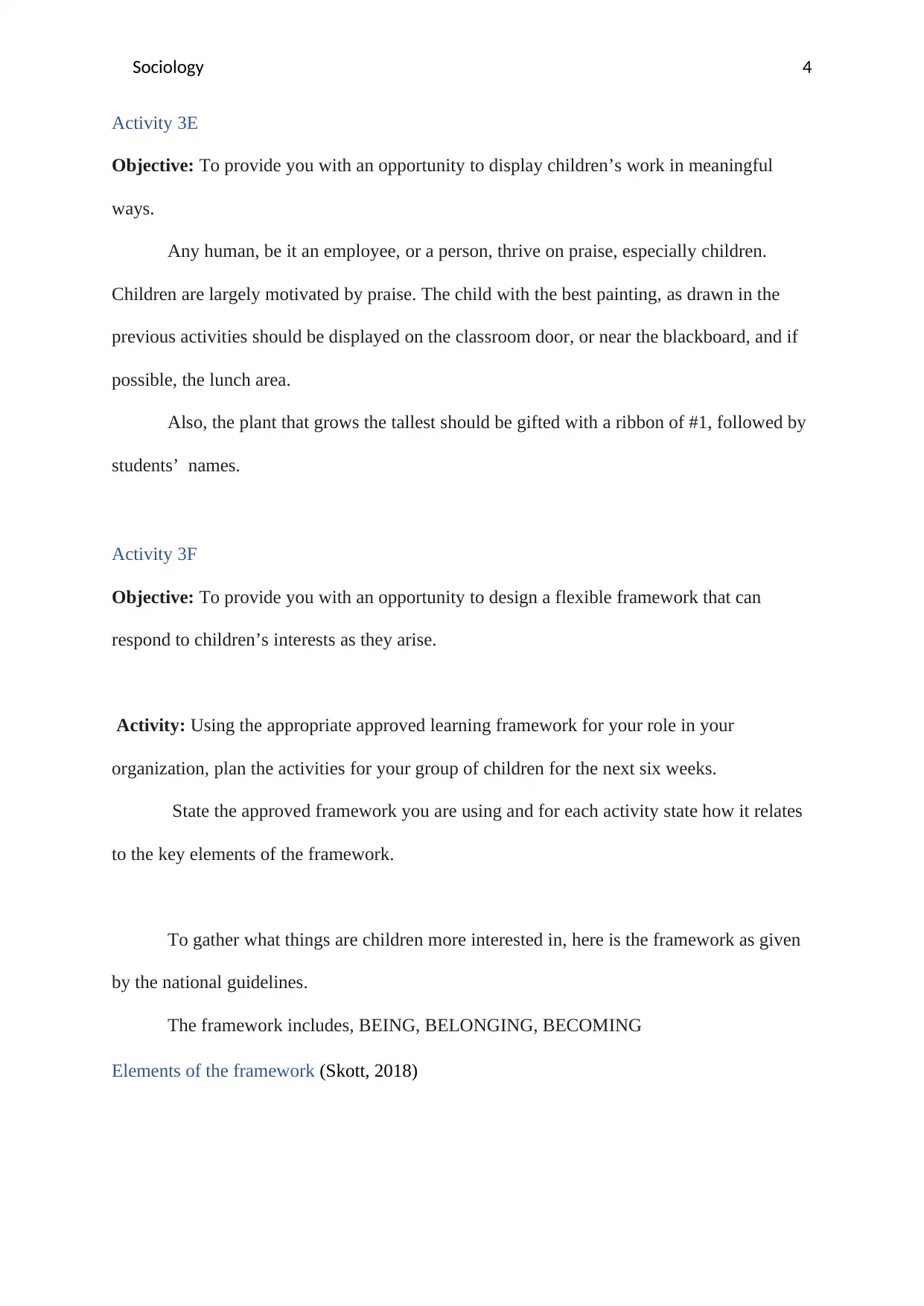
Sociology 4
Activity 3E
Objective: To provide you with an opportunity to display children’s work in meaningful
ways.
Any human, be it an employee, or a person, thrive on praise, especially children.
Children are largely motivated by praise. The child with the best painting, as drawn in the
previous activities should be displayed on the classroom door, or near the blackboard, and if
possible, the lunch area.
Also, the plant that grows the tallest should be gifted with a ribbon of #1, followed by
students’ names.
Activity 3F
Objective: To provide you with an opportunity to design a flexible framework that can
respond to children’s interests as they arise.
Activity: Using the appropriate approved learning framework for your role in your
organization, plan the activities for your group of children for the next six weeks.
State the approved framework you are using and for each activity state how it relates
to the key elements of the framework.
To gather what things are children more interested in, here is the framework as given
by the national guidelines.
The framework includes, BEING, BELONGING, BECOMING
Elements of the framework (Skott, 2018)
Activity 3E
Objective: To provide you with an opportunity to display children’s work in meaningful
ways.
Any human, be it an employee, or a person, thrive on praise, especially children.
Children are largely motivated by praise. The child with the best painting, as drawn in the
previous activities should be displayed on the classroom door, or near the blackboard, and if
possible, the lunch area.
Also, the plant that grows the tallest should be gifted with a ribbon of #1, followed by
students’ names.
Activity 3F
Objective: To provide you with an opportunity to design a flexible framework that can
respond to children’s interests as they arise.
Activity: Using the appropriate approved learning framework for your role in your
organization, plan the activities for your group of children for the next six weeks.
State the approved framework you are using and for each activity state how it relates
to the key elements of the framework.
To gather what things are children more interested in, here is the framework as given
by the national guidelines.
The framework includes, BEING, BELONGING, BECOMING
Elements of the framework (Skott, 2018)
Paraphrase This Document
Need a fresh take? Get an instant paraphrase of this document with our AI Paraphraser
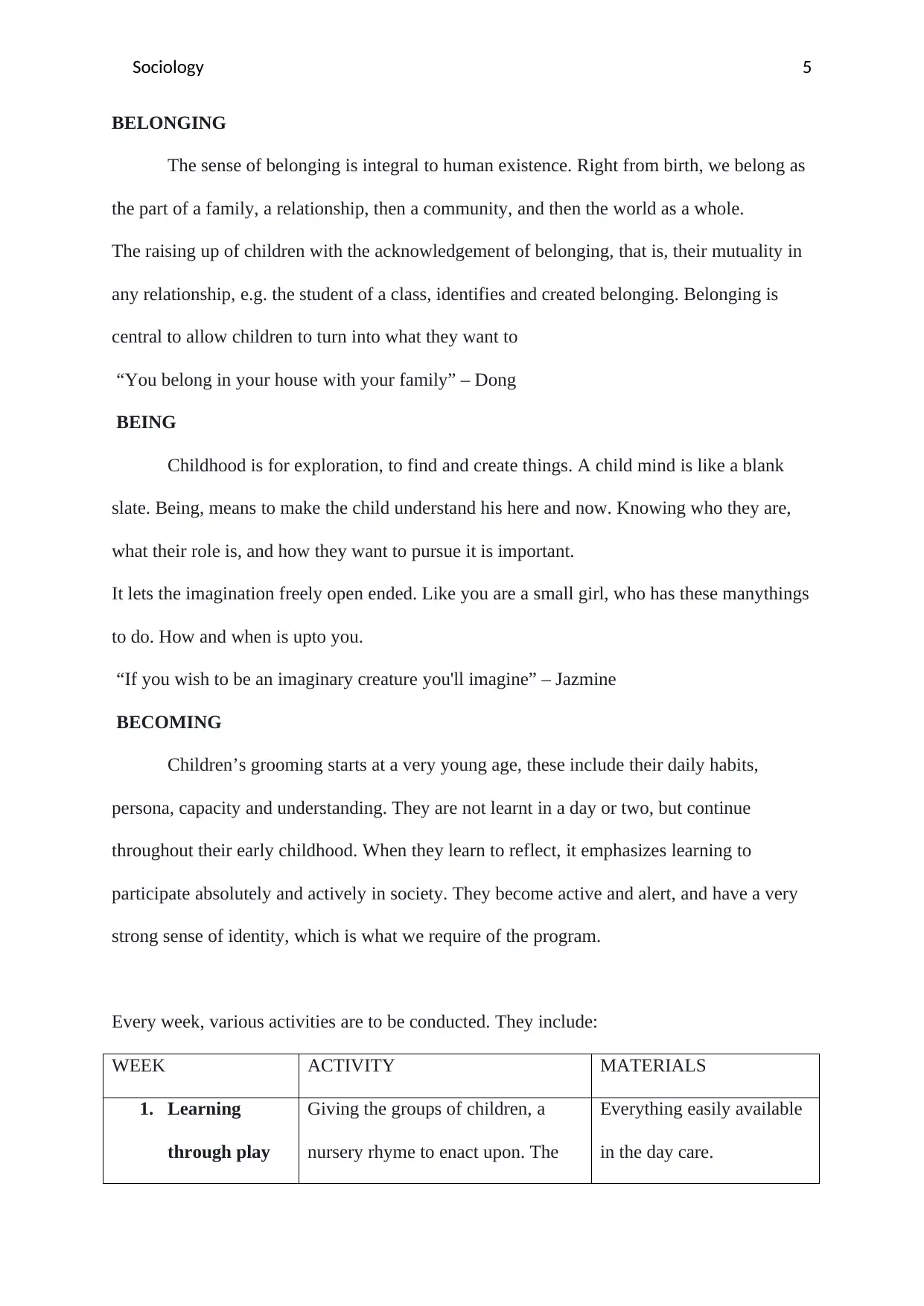
Sociology 5
BELONGING
The sense of belonging is integral to human existence. Right from birth, we belong as
the part of a family, a relationship, then a community, and then the world as a whole.
The raising up of children with the acknowledgement of belonging, that is, their mutuality in
any relationship, e.g. the student of a class, identifies and created belonging. Belonging is
central to allow children to turn into what they want to
“You belong in your house with your family” – Dong
BEING
Childhood is for exploration, to find and create things. A child mind is like a blank
slate. Being, means to make the child understand his here and now. Knowing who they are,
what their role is, and how they want to pursue it is important.
It lets the imagination freely open ended. Like you are a small girl, who has these manythings
to do. How and when is upto you.
“If you wish to be an imaginary creature you'll imagine” – Jazmine
BECOMING
Children’s grooming starts at a very young age, these include their daily habits,
persona, capacity and understanding. They are not learnt in a day or two, but continue
throughout their early childhood. When they learn to reflect, it emphasizes learning to
participate absolutely and actively in society. They become active and alert, and have a very
strong sense of identity, which is what we require of the program.
Every week, various activities are to be conducted. They include:
WEEK ACTIVITY MATERIALS
1. Learning
through play
Giving the groups of children, a
nursery rhyme to enact upon. The
Everything easily available
in the day care.
BELONGING
The sense of belonging is integral to human existence. Right from birth, we belong as
the part of a family, a relationship, then a community, and then the world as a whole.
The raising up of children with the acknowledgement of belonging, that is, their mutuality in
any relationship, e.g. the student of a class, identifies and created belonging. Belonging is
central to allow children to turn into what they want to
“You belong in your house with your family” – Dong
BEING
Childhood is for exploration, to find and create things. A child mind is like a blank
slate. Being, means to make the child understand his here and now. Knowing who they are,
what their role is, and how they want to pursue it is important.
It lets the imagination freely open ended. Like you are a small girl, who has these manythings
to do. How and when is upto you.
“If you wish to be an imaginary creature you'll imagine” – Jazmine
BECOMING
Children’s grooming starts at a very young age, these include their daily habits,
persona, capacity and understanding. They are not learnt in a day or two, but continue
throughout their early childhood. When they learn to reflect, it emphasizes learning to
participate absolutely and actively in society. They become active and alert, and have a very
strong sense of identity, which is what we require of the program.
Every week, various activities are to be conducted. They include:
WEEK ACTIVITY MATERIALS
1. Learning
through play
Giving the groups of children, a
nursery rhyme to enact upon. The
Everything easily available
in the day care.
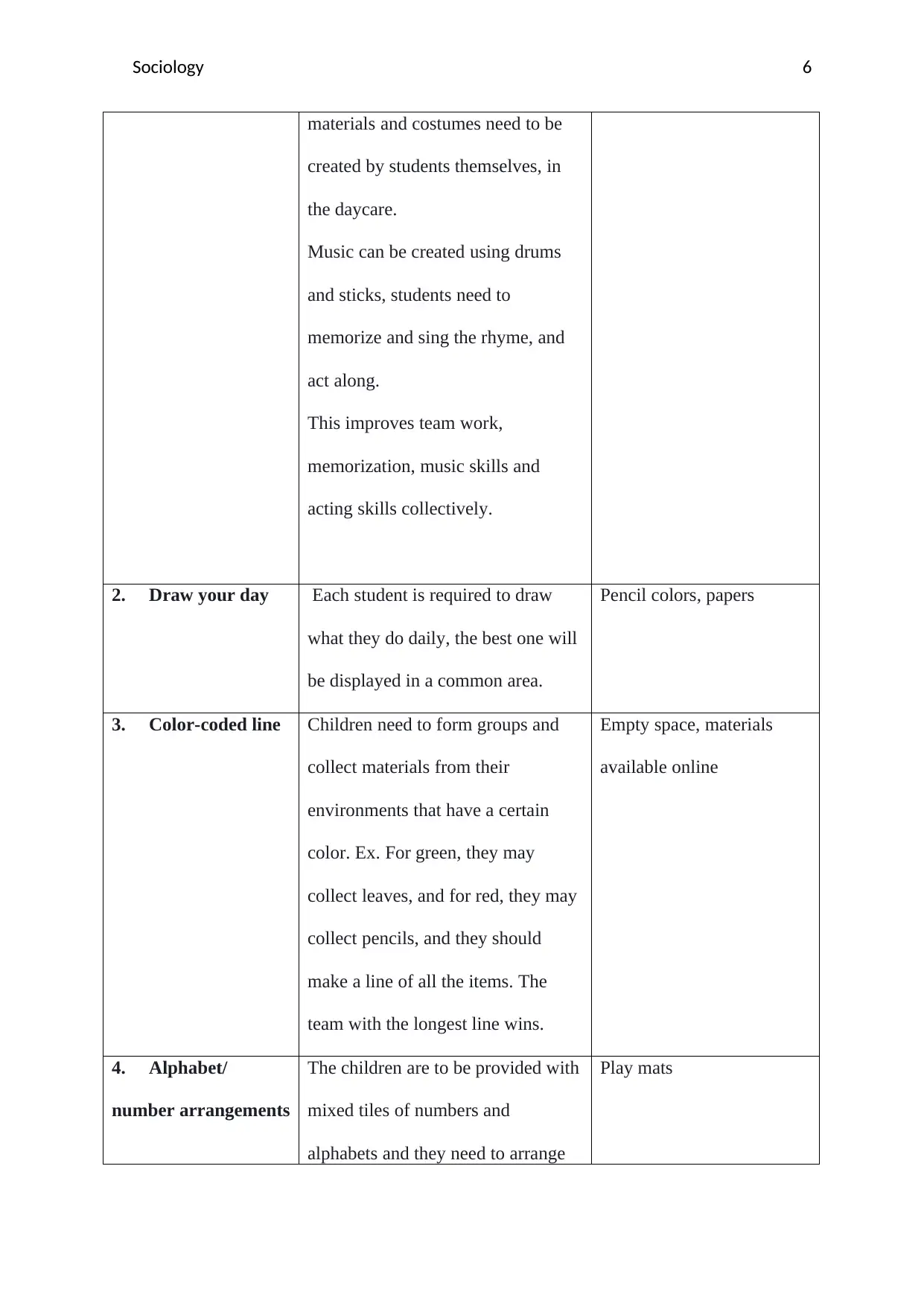
Sociology 6
materials and costumes need to be
created by students themselves, in
the daycare.
Music can be created using drums
and sticks, students need to
memorize and sing the rhyme, and
act along.
This improves team work,
memorization, music skills and
acting skills collectively.
2. Draw your day Each student is required to draw
what they do daily, the best one will
be displayed in a common area.
Pencil colors, papers
3. Color-coded line Children need to form groups and
collect materials from their
environments that have a certain
color. Ex. For green, they may
collect leaves, and for red, they may
collect pencils, and they should
make a line of all the items. The
team with the longest line wins.
Empty space, materials
available online
4. Alphabet/
number arrangements
The children are to be provided with
mixed tiles of numbers and
alphabets and they need to arrange
Play mats
materials and costumes need to be
created by students themselves, in
the daycare.
Music can be created using drums
and sticks, students need to
memorize and sing the rhyme, and
act along.
This improves team work,
memorization, music skills and
acting skills collectively.
2. Draw your day Each student is required to draw
what they do daily, the best one will
be displayed in a common area.
Pencil colors, papers
3. Color-coded line Children need to form groups and
collect materials from their
environments that have a certain
color. Ex. For green, they may
collect leaves, and for red, they may
collect pencils, and they should
make a line of all the items. The
team with the longest line wins.
Empty space, materials
available online
4. Alphabet/
number arrangements
The children are to be provided with
mixed tiles of numbers and
alphabets and they need to arrange
Play mats
⊘ This is a preview!⊘
Do you want full access?
Subscribe today to unlock all pages.

Trusted by 1+ million students worldwide
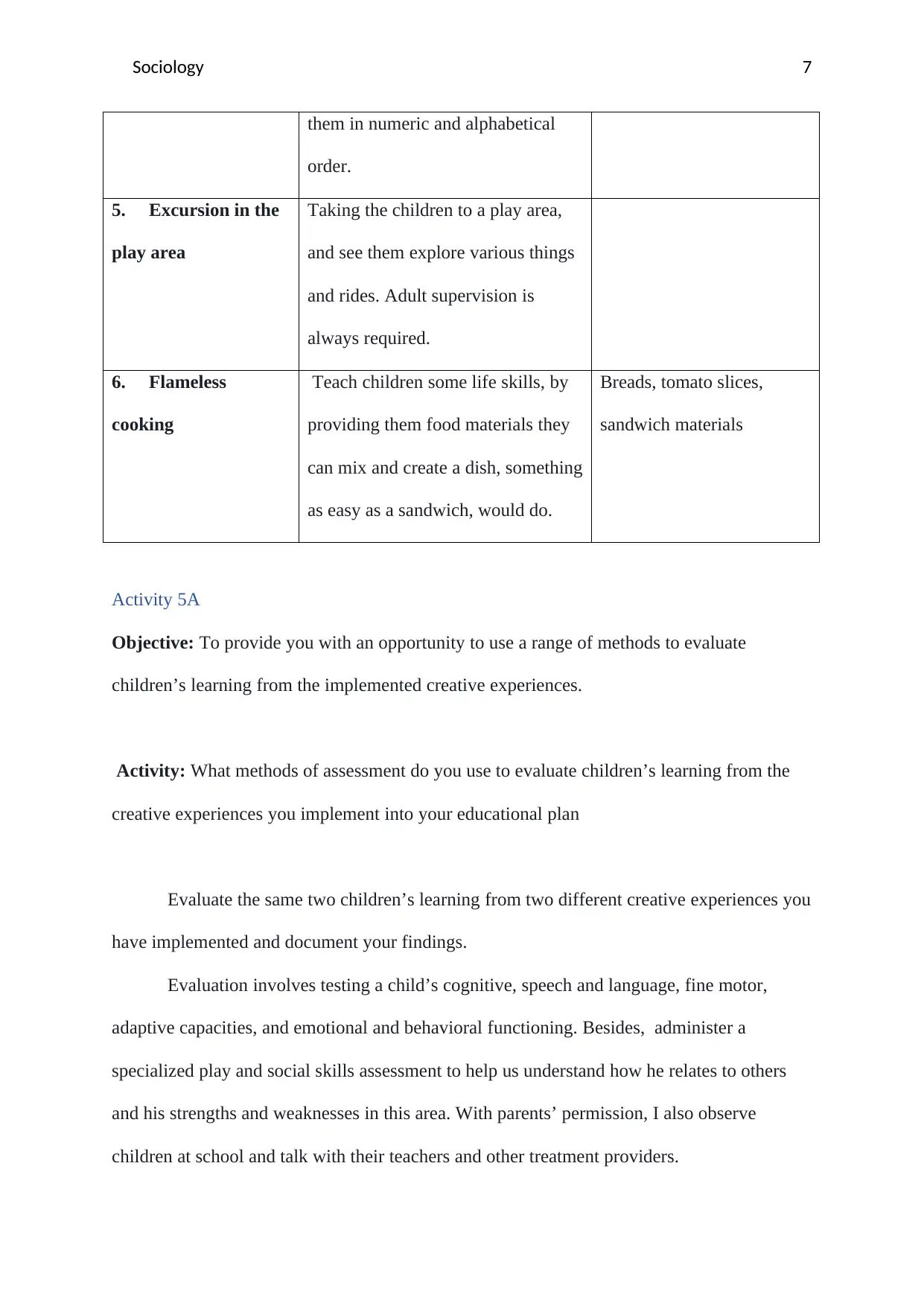
Sociology 7
them in numeric and alphabetical
order.
5. Excursion in the
play area
Taking the children to a play area,
and see them explore various things
and rides. Adult supervision is
always required.
6. Flameless
cooking
Teach children some life skills, by
providing them food materials they
can mix and create a dish, something
as easy as a sandwich, would do.
Breads, tomato slices,
sandwich materials
Activity 5A
Objective: To provide you with an opportunity to use a range of methods to evaluate
children’s learning from the implemented creative experiences.
Activity: What methods of assessment do you use to evaluate children’s learning from the
creative experiences you implement into your educational plan
Evaluate the same two children’s learning from two different creative experiences you
have implemented and document your findings.
Evaluation involves testing a child’s cognitive, speech and language, fine motor,
adaptive capacities, and emotional and behavioral functioning. Besides, administer a
specialized play and social skills assessment to help us understand how he relates to others
and his strengths and weaknesses in this area. With parents’ permission, I also observe
children at school and talk with their teachers and other treatment providers.
them in numeric and alphabetical
order.
5. Excursion in the
play area
Taking the children to a play area,
and see them explore various things
and rides. Adult supervision is
always required.
6. Flameless
cooking
Teach children some life skills, by
providing them food materials they
can mix and create a dish, something
as easy as a sandwich, would do.
Breads, tomato slices,
sandwich materials
Activity 5A
Objective: To provide you with an opportunity to use a range of methods to evaluate
children’s learning from the implemented creative experiences.
Activity: What methods of assessment do you use to evaluate children’s learning from the
creative experiences you implement into your educational plan
Evaluate the same two children’s learning from two different creative experiences you
have implemented and document your findings.
Evaluation involves testing a child’s cognitive, speech and language, fine motor,
adaptive capacities, and emotional and behavioral functioning. Besides, administer a
specialized play and social skills assessment to help us understand how he relates to others
and his strengths and weaknesses in this area. With parents’ permission, I also observe
children at school and talk with their teachers and other treatment providers.
Paraphrase This Document
Need a fresh take? Get an instant paraphrase of this document with our AI Paraphraser
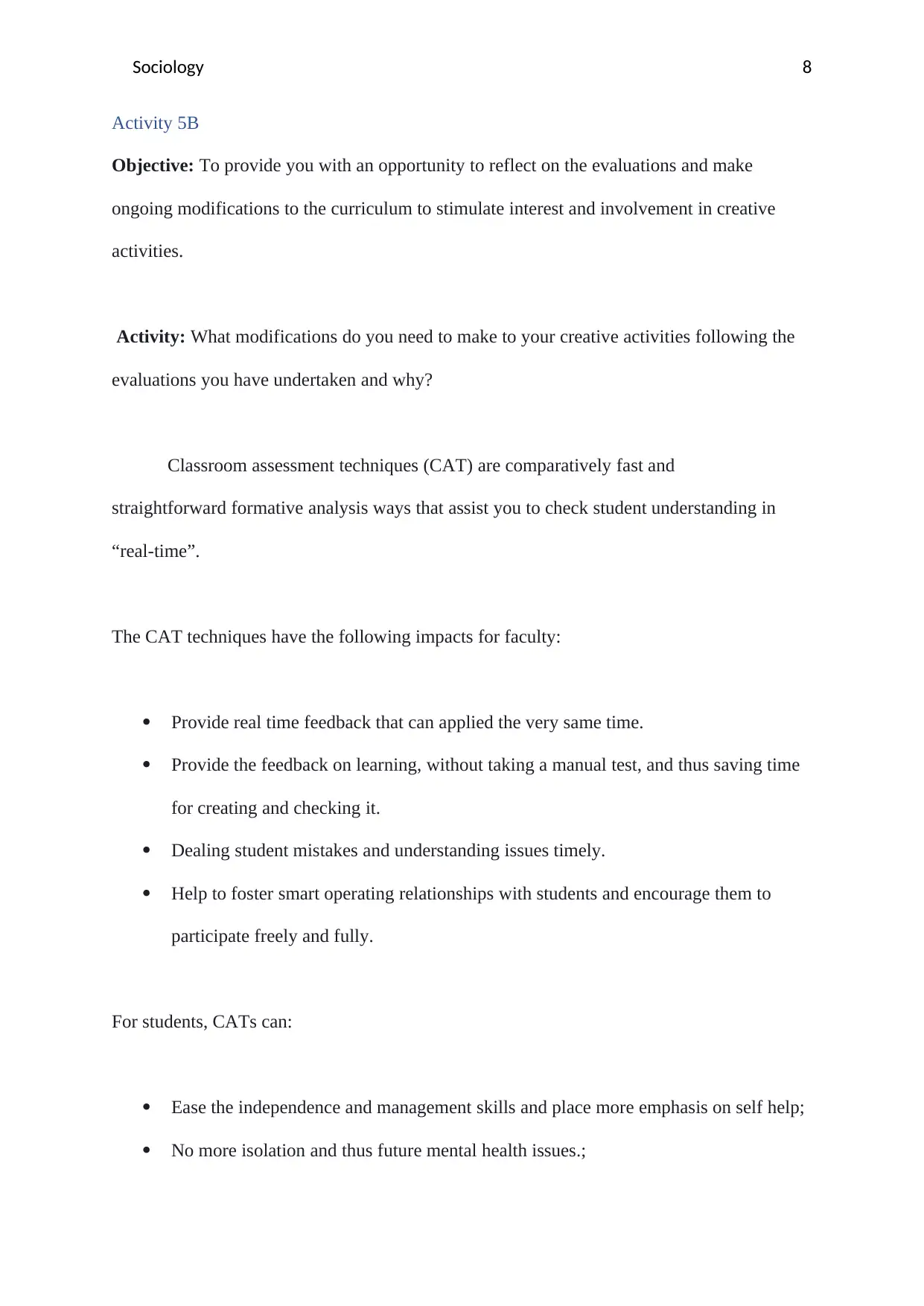
Sociology 8
Activity 5B
Objective: To provide you with an opportunity to reflect on the evaluations and make
ongoing modifications to the curriculum to stimulate interest and involvement in creative
activities.
Activity: What modifications do you need to make to your creative activities following the
evaluations you have undertaken and why?
Classroom assessment techniques (CAT) are comparatively fast and
straightforward formative analysis ways that assist you to check student understanding in
“real-time”.
The CAT techniques have the following impacts for faculty:
Provide real time feedback that can applied the very same time.
Provide the feedback on learning, without taking a manual test, and thus saving time
for creating and checking it.
Dealing student mistakes and understanding issues timely.
Help to foster smart operating relationships with students and encourage them to
participate freely and fully.
For students, CATs can:
Ease the independence and management skills and place more emphasis on self help;
No more isolation and thus future mental health issues.;
Activity 5B
Objective: To provide you with an opportunity to reflect on the evaluations and make
ongoing modifications to the curriculum to stimulate interest and involvement in creative
activities.
Activity: What modifications do you need to make to your creative activities following the
evaluations you have undertaken and why?
Classroom assessment techniques (CAT) are comparatively fast and
straightforward formative analysis ways that assist you to check student understanding in
“real-time”.
The CAT techniques have the following impacts for faculty:
Provide real time feedback that can applied the very same time.
Provide the feedback on learning, without taking a manual test, and thus saving time
for creating and checking it.
Dealing student mistakes and understanding issues timely.
Help to foster smart operating relationships with students and encourage them to
participate freely and fully.
For students, CATs can:
Ease the independence and management skills and place more emphasis on self help;
No more isolation and thus future mental health issues.;
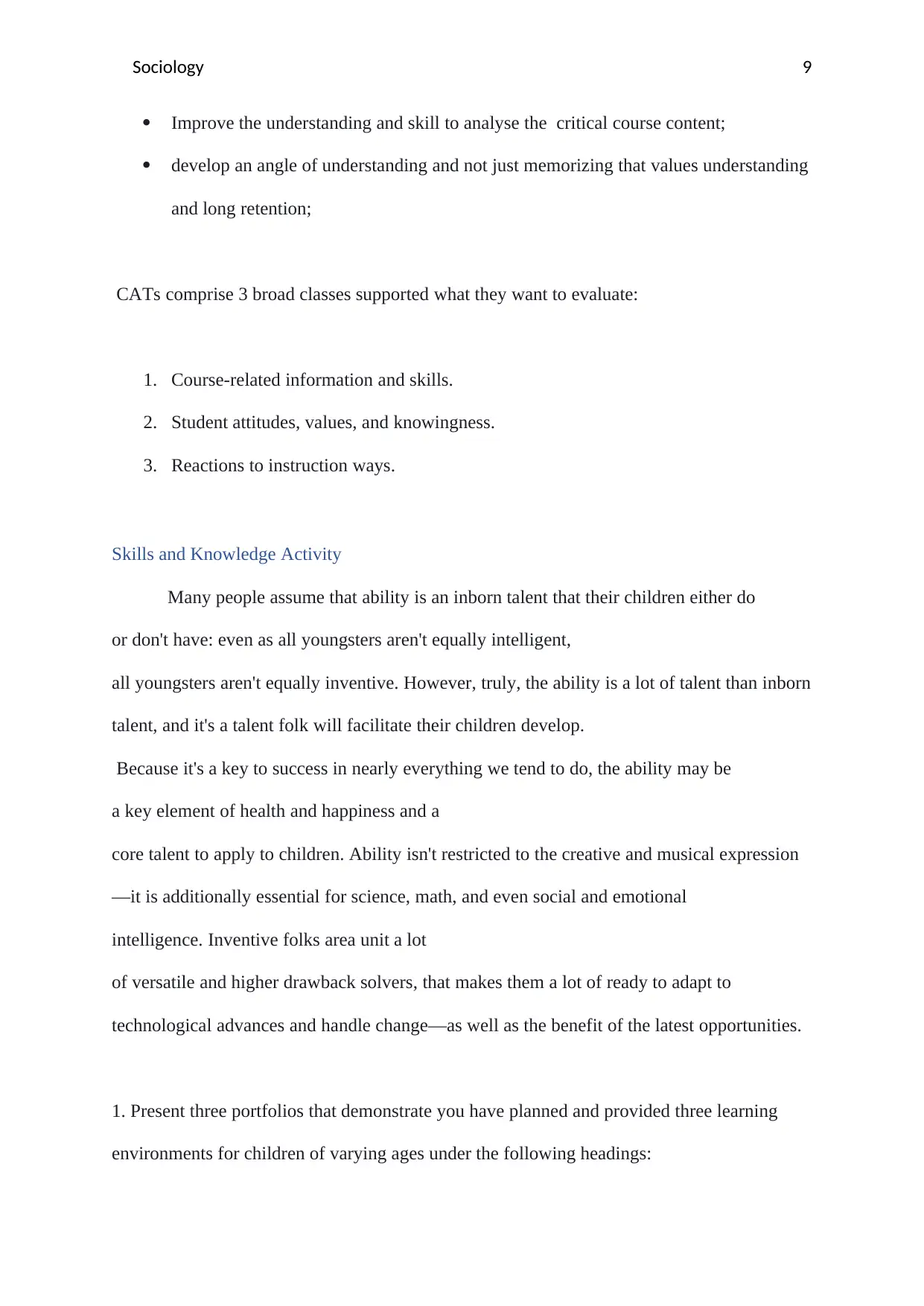
Sociology 9
Improve the understanding and skill to analyse the critical course content;
develop an angle of understanding and not just memorizing that values understanding
and long retention;
CATs comprise 3 broad classes supported what they want to evaluate:
1. Course-related information and skills.
2. Student attitudes, values, and knowingness.
3. Reactions to instruction ways.
Skills and Knowledge Activity
Many people assume that ability is an inborn talent that their children either do
or don't have: even as all youngsters aren't equally intelligent,
all youngsters aren't equally inventive. However, truly, the ability is a lot of talent than inborn
talent, and it's a talent folk will facilitate their children develop.
Because it's a key to success in nearly everything we tend to do, the ability may be
a key element of health and happiness and a
core talent to apply to children. Ability isn't restricted to the creative and musical expression
—it is additionally essential for science, math, and even social and emotional
intelligence. Inventive folks area unit a lot
of versatile and higher drawback solvers, that makes them a lot of ready to adapt to
technological advances and handle change—as well as the benefit of the latest opportunities.
1. Present three portfolios that demonstrate you have planned and provided three learning
environments for children of varying ages under the following headings:
Improve the understanding and skill to analyse the critical course content;
develop an angle of understanding and not just memorizing that values understanding
and long retention;
CATs comprise 3 broad classes supported what they want to evaluate:
1. Course-related information and skills.
2. Student attitudes, values, and knowingness.
3. Reactions to instruction ways.
Skills and Knowledge Activity
Many people assume that ability is an inborn talent that their children either do
or don't have: even as all youngsters aren't equally intelligent,
all youngsters aren't equally inventive. However, truly, the ability is a lot of talent than inborn
talent, and it's a talent folk will facilitate their children develop.
Because it's a key to success in nearly everything we tend to do, the ability may be
a key element of health and happiness and a
core talent to apply to children. Ability isn't restricted to the creative and musical expression
—it is additionally essential for science, math, and even social and emotional
intelligence. Inventive folks area unit a lot
of versatile and higher drawback solvers, that makes them a lot of ready to adapt to
technological advances and handle change—as well as the benefit of the latest opportunities.
1. Present three portfolios that demonstrate you have planned and provided three learning
environments for children of varying ages under the following headings:
⊘ This is a preview!⊘
Do you want full access?
Subscribe today to unlock all pages.

Trusted by 1+ million students worldwide
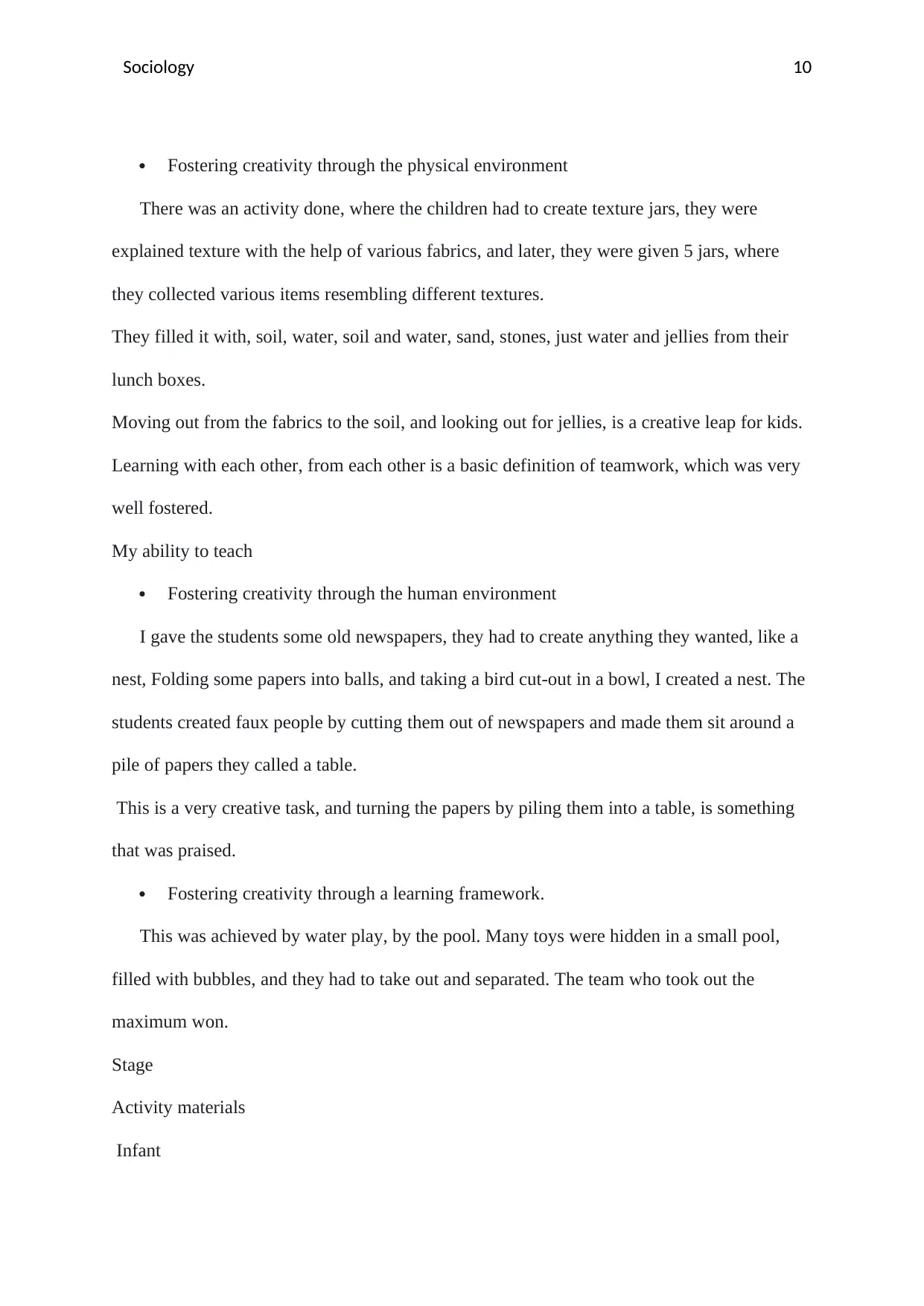
Sociology 10
Fostering creativity through the physical environment
There was an activity done, where the children had to create texture jars, they were
explained texture with the help of various fabrics, and later, they were given 5 jars, where
they collected various items resembling different textures.
They filled it with, soil, water, soil and water, sand, stones, just water and jellies from their
lunch boxes.
Moving out from the fabrics to the soil, and looking out for jellies, is a creative leap for kids.
Learning with each other, from each other is a basic definition of teamwork, which was very
well fostered.
My ability to teach
Fostering creativity through the human environment
I gave the students some old newspapers, they had to create anything they wanted, like a
nest, Folding some papers into balls, and taking a bird cut-out in a bowl, I created a nest. The
students created faux people by cutting them out of newspapers and made them sit around a
pile of papers they called a table.
This is a very creative task, and turning the papers by piling them into a table, is something
that was praised.
Fostering creativity through a learning framework.
This was achieved by water play, by the pool. Many toys were hidden in a small pool,
filled with bubbles, and they had to take out and separated. The team who took out the
maximum won.
Stage
Activity materials
Infant
Fostering creativity through the physical environment
There was an activity done, where the children had to create texture jars, they were
explained texture with the help of various fabrics, and later, they were given 5 jars, where
they collected various items resembling different textures.
They filled it with, soil, water, soil and water, sand, stones, just water and jellies from their
lunch boxes.
Moving out from the fabrics to the soil, and looking out for jellies, is a creative leap for kids.
Learning with each other, from each other is a basic definition of teamwork, which was very
well fostered.
My ability to teach
Fostering creativity through the human environment
I gave the students some old newspapers, they had to create anything they wanted, like a
nest, Folding some papers into balls, and taking a bird cut-out in a bowl, I created a nest. The
students created faux people by cutting them out of newspapers and made them sit around a
pile of papers they called a table.
This is a very creative task, and turning the papers by piling them into a table, is something
that was praised.
Fostering creativity through a learning framework.
This was achieved by water play, by the pool. Many toys were hidden in a small pool,
filled with bubbles, and they had to take out and separated. The team who took out the
maximum won.
Stage
Activity materials
Infant
Paraphrase This Document
Need a fresh take? Get an instant paraphrase of this document with our AI Paraphraser
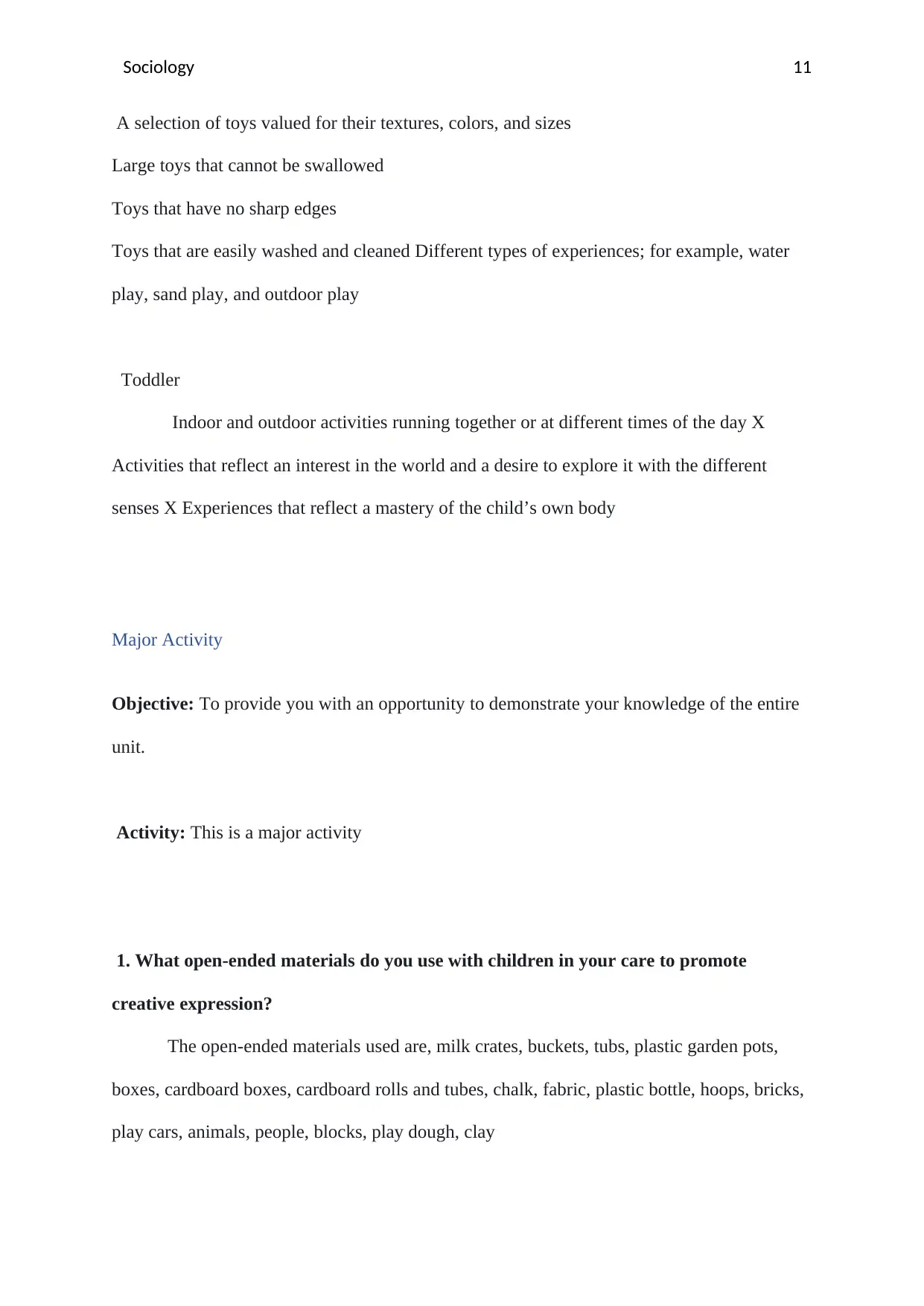
Sociology 11
A selection of toys valued for their textures, colors, and sizes
Large toys that cannot be swallowed
Toys that have no sharp edges
Toys that are easily washed and cleaned Different types of experiences; for example, water
play, sand play, and outdoor play
Toddler
Indoor and outdoor activities running together or at different times of the day X
Activities that reflect an interest in the world and a desire to explore it with the different
senses X Experiences that reflect a mastery of the child’s own body
Major Activity
Objective: To provide you with an opportunity to demonstrate your knowledge of the entire
unit.
Activity: This is a major activity
1. What open-ended materials do you use with children in your care to promote
creative expression?
The open-ended materials used are, milk crates, buckets, tubs, plastic garden pots,
boxes, cardboard boxes, cardboard rolls and tubes, chalk, fabric, plastic bottle, hoops, bricks,
play cars, animals, people, blocks, play dough, clay
A selection of toys valued for their textures, colors, and sizes
Large toys that cannot be swallowed
Toys that have no sharp edges
Toys that are easily washed and cleaned Different types of experiences; for example, water
play, sand play, and outdoor play
Toddler
Indoor and outdoor activities running together or at different times of the day X
Activities that reflect an interest in the world and a desire to explore it with the different
senses X Experiences that reflect a mastery of the child’s own body
Major Activity
Objective: To provide you with an opportunity to demonstrate your knowledge of the entire
unit.
Activity: This is a major activity
1. What open-ended materials do you use with children in your care to promote
creative expression?
The open-ended materials used are, milk crates, buckets, tubs, plastic garden pots,
boxes, cardboard boxes, cardboard rolls and tubes, chalk, fabric, plastic bottle, hoops, bricks,
play cars, animals, people, blocks, play dough, clay
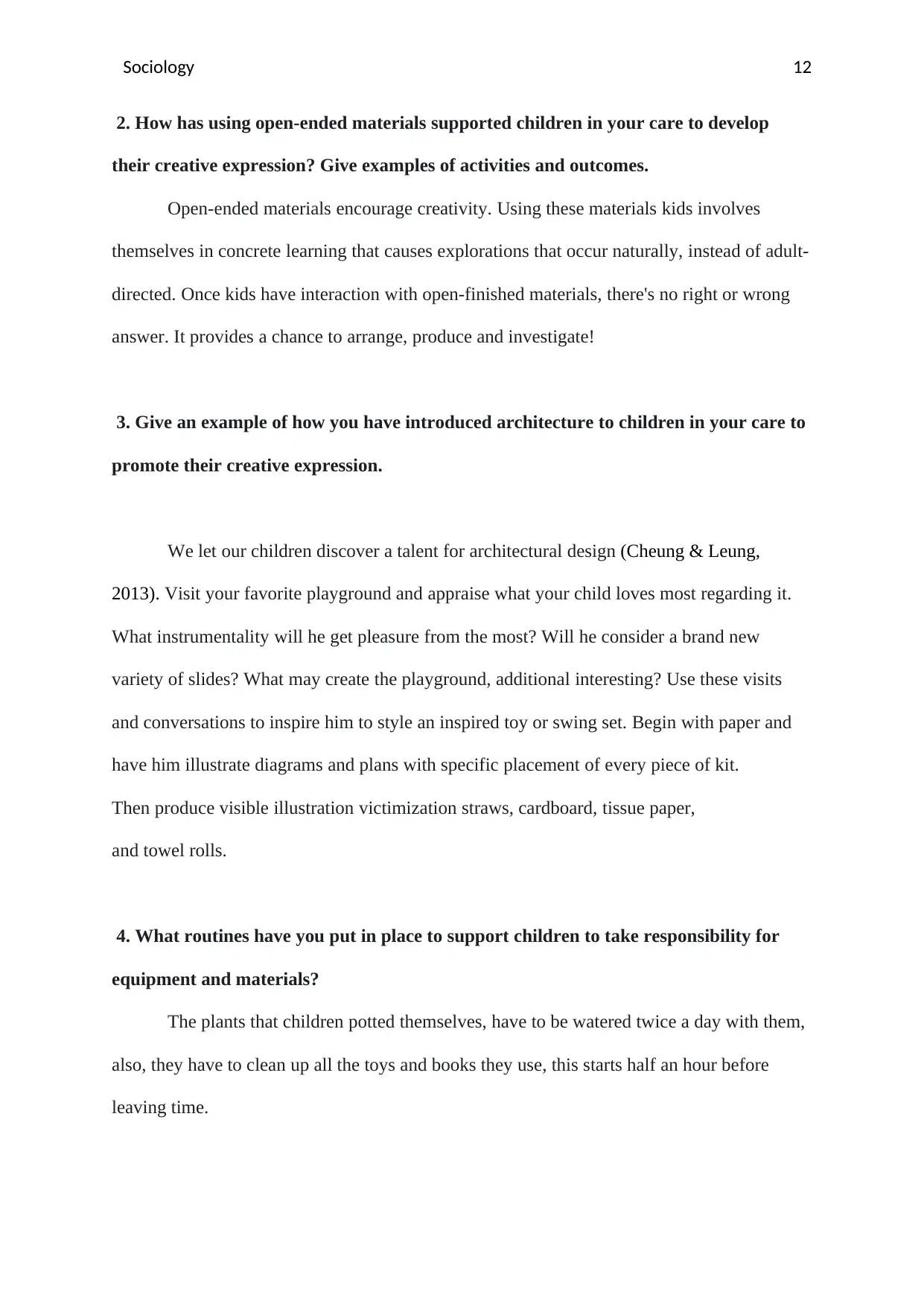
Sociology 12
2. How has using open-ended materials supported children in your care to develop
their creative expression? Give examples of activities and outcomes.
Open-ended materials encourage creativity. Using these materials kids involves
themselves in concrete learning that causes explorations that occur naturally, instead of adult-
directed. Once kids have interaction with open-finished materials, there's no right or wrong
answer. It provides a chance to arrange, produce and investigate!
3. Give an example of how you have introduced architecture to children in your care to
promote their creative expression.
We let our children discover a talent for architectural design (Cheung & Leung,
2013). Visit your favorite playground and appraise what your child loves most regarding it.
What instrumentality will he get pleasure from the most? Will he consider a brand new
variety of slides? What may create the playground, additional interesting? Use these visits
and conversations to inspire him to style an inspired toy or swing set. Begin with paper and
have him illustrate diagrams and plans with specific placement of every piece of kit.
Then produce visible illustration victimization straws, cardboard, tissue paper,
and towel rolls.
4. What routines have you put in place to support children to take responsibility for
equipment and materials?
The plants that children potted themselves, have to be watered twice a day with them,
also, they have to clean up all the toys and books they use, this starts half an hour before
leaving time.
2. How has using open-ended materials supported children in your care to develop
their creative expression? Give examples of activities and outcomes.
Open-ended materials encourage creativity. Using these materials kids involves
themselves in concrete learning that causes explorations that occur naturally, instead of adult-
directed. Once kids have interaction with open-finished materials, there's no right or wrong
answer. It provides a chance to arrange, produce and investigate!
3. Give an example of how you have introduced architecture to children in your care to
promote their creative expression.
We let our children discover a talent for architectural design (Cheung & Leung,
2013). Visit your favorite playground and appraise what your child loves most regarding it.
What instrumentality will he get pleasure from the most? Will he consider a brand new
variety of slides? What may create the playground, additional interesting? Use these visits
and conversations to inspire him to style an inspired toy or swing set. Begin with paper and
have him illustrate diagrams and plans with specific placement of every piece of kit.
Then produce visible illustration victimization straws, cardboard, tissue paper,
and towel rolls.
4. What routines have you put in place to support children to take responsibility for
equipment and materials?
The plants that children potted themselves, have to be watered twice a day with them,
also, they have to clean up all the toys and books they use, this starts half an hour before
leaving time.
⊘ This is a preview!⊘
Do you want full access?
Subscribe today to unlock all pages.

Trusted by 1+ million students worldwide
1 out of 17
Your All-in-One AI-Powered Toolkit for Academic Success.
+13062052269
info@desklib.com
Available 24*7 on WhatsApp / Email
![[object Object]](/_next/static/media/star-bottom.7253800d.svg)
Unlock your academic potential
Copyright © 2020–2025 A2Z Services. All Rights Reserved. Developed and managed by ZUCOL.